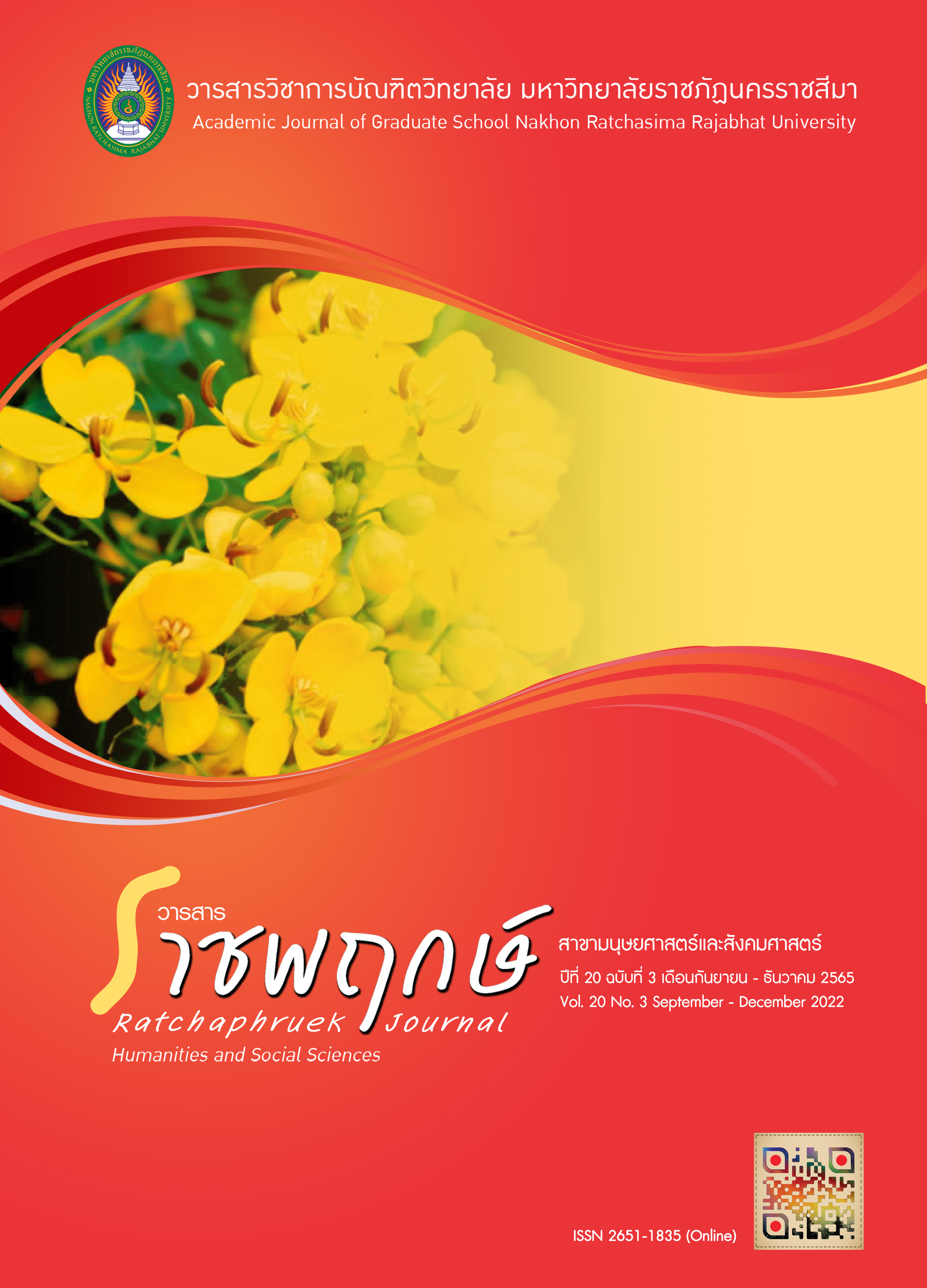A STEM-Based Learning Approach in Enhancing Problem Solving Skills in the Topic of “Electricity” for Grade 6 Students
Main Article Content
Abstract
The research was the classroom action research consisting of 3 cycles.The purpose of this research was to study a STEM-based learning approach promoting problem solving skills in Grade 6th students in the topic of “Electricity”. The participants were 43 0f 6th grade students selected by purposive sampling. Research instruments comprised the lesson plans, the problem-solving skills test, the problem-solving skills observation form, and the reflective journal and worksheet. Data were analyzed by using qualitative data analysis and quantitative data analysis, which were content analysis, mean, percentage and triangulations were used to analyze the data.
The research results indicated that there were 5 steps to develop problem-solving skill: Identify a challenge step; Explore ideas step; Solution design step; Planning and problems solving step; and Test and evaluate step. The results of test may be used to improve and develop the work piece to move effectively solve the problem.For the presentation the solution step, students need to present their work piece to teacher and students. Presentation should be simplified to understand and interesting. The students continually improved their problem-solving skills, and most students appeared to have the best problem-solving skills in problem identification, 81.39 percent.
Article Details

This work is licensed under a Creative Commons Attribution-NonCommercial-NoDerivatives 4.0 International License.
References
กฤษลดา ชูสินคุณาวุฒิ. (2557). รอบรู้เทคโนโลยี: กระบวนการออกแบบเชิงวิศวกรรมคืออะไร?. สสวท., 42(190), น. 37-39.
ธนวรรธณ์ ศรีวิบูลย์รัตน์. (2561). การพัฒนากิจกรรมการเรียนรู้ตามแนวคิดสะเต็มศึกษาเพื่อพัฒนาความสามารถในการคิดแก้ปัญหา เรื่องงานและพลังงาน รายวิชาฟิสิกส์ สำหรับนักเรียนชั้นมัธยมศึกษาปีที่ 4 (วิทยานิพนธ์มหาบัณฑิต, มหาวิทยาลัยนเรศวร).
นัตยา หัสมินทร์. (2563). การจัดการเรียนรู้ตามแนวทางสะเต็มศึกษาที่เน้นกระบวนการออกแบบเชิงวิศวกรรม เพื่อส่งเสริมสมรรถนะการแก้ปัญหาแบบร่วมมือ เรื่องการเคลื่อนที่แบบต่างๆ ของนักเรียนชั้นมัธยมศึกษาปีที่ 4 (วิทยานิพนธ์มหาบัณฑิต, มหาวิทยาลัยนเรศวร).
ประพันธ์ศิริ สุเสารัจ. (2556). การพัฒนาการคิด (พิมพ์ครั้งที่ 8). กรุงเทพฯ: 9119 เทคนิคพริ้นติ้ง.
ปาลิตา สุขสำราญ. (2560). การพัฒนารูปแบบการจัดการเรียนรู้วิทยาศาสตร์ตามแนวคิดสะเต็มศึกษาที่ส่งเสริมจิตวิทยาศาสตร์และทักษะการแก้ปัญหาสำหรับนักเรียนระดับประถมศึกษา(วิทยานิพนธ์ดุษฎีบัณฑิต, มหาวิทยาลัยนเรศวร).
พัทธดนัย อุดมสันติ. (2560). การพัฒนาการรู้วิทยาศาสตร์โดยการจัดการเรียนรู้ที่ใช้กระบวนการออกแบบเชิงวิศวกรรมตามแนวคิดสะเต็มศึกษา เรื่อง แสงและทัศนูปกรณ์ ของนักเรียนชั้นมัธยมศึกษาปีที่ 5 (วิทยานิพนธ์มหาบัณฑิต, มหาวิทยาลัยนเรศวร).
สถาบันส่งเสริมการสอนวิทยาศาสตร์และเทคโนโลยี. (2564). ผลการประเมิน PISA 2018 การอ่าน คณิตศาสตร์ และวิทยาศาสตร์. กรุงเทพฯ: โรงพิมพ์ สกสค. ลาดพร้าว.
สถาบันส่งเสริมการสอนวิทยาศาสตร์และเทคโนโลยี. (2560). เอกสารจัดกิจกรรมการเรียนรู้สะเต็มศึกษา. กรุงเทพฯ: โรงพิมพ์ สกสค. ลาดพร้าว.
สิรินภา กิจเกื้อกูล. (2558). สะเต็มศึกษา (ตอนที่ 2): การบูรณาการสะเต็มศึกษาสู่การจัดการเรียนรู้ ในชั้นเรียน. วารสารศึกษาศาสตร์ มหาวิทยาลัยนเรศวร, 17(3), น. 154-160.
สิรินภา กิจเกื้อกูล. (2565). การจัดการเรียนรู้วิทยาศาสตร์. พิษณุโลก: มหาวิทยาลัยนเรศวร.
อภิญญา สิงห์โต. (2563). การพัฒนากิจกรรมการเรียนรู้แบบสะเต็มศึกษาที่ส่งเสริมความสามารถในการคิดแก้ปัญหา สำหรับนักเรียนชั้นมัธยมศึกษาปีที่ 1 (วิทยานิพนธ์มหาบัณฑิต, มหาวิทยาลัยนเรศวร).
อาทิตย์ ฉิมกุล. (2559). การพัฒนากิจกรรมสะเต็มศึกษาเพื่อส่งเสริมทักษะการแก้ปัญหาและพฤติกรรมใฝ่เรียนรู้ สำหรับนักเรียนชั้นมัธยมศึกษาปีที่ 3 สำนักงานเขตพื้นที่การศึกษามัธยมศึกษา เขต 33 (วิทยานิพนธ์มหาบัณฑิต, จุฬาลงกรณ์มหาวิทยาลัย).
Morgan, J. R. Capraro, M. M. & Caprara, R. M. (2013). STEM project-based learning: An integrated science, technology, engineering, and Mathematics (STEM) approach. Rotterdam: Sense.
National Research Council (NCR). (2012). A Framework for K-12 Science Education: Practices, Crosscutting Concepts, and Core Ideas. Washington, D.C.: National Academy Press.
Organization for Economic Co-operation and Development (OECD). (2015). PISA 2015 draft collaborative problem solving framework. Paris: OECD.
Schmuck, R. A. (2006). Practical Action Research for Change. Thousand Oaks, California: Corwin Press.
Vasquez, J. A., Sneider, C. & Comer, M. (2013). STEM lesson essentials, Grades 3-8 Integrating science, technology, engineering, and mathematics. Portsmouth, New Hampshire: Heinemann.
Weir, J. J. (1974). Problem is everybody’s problem. The Science Teacher, 41(4), pp. 16-18.


